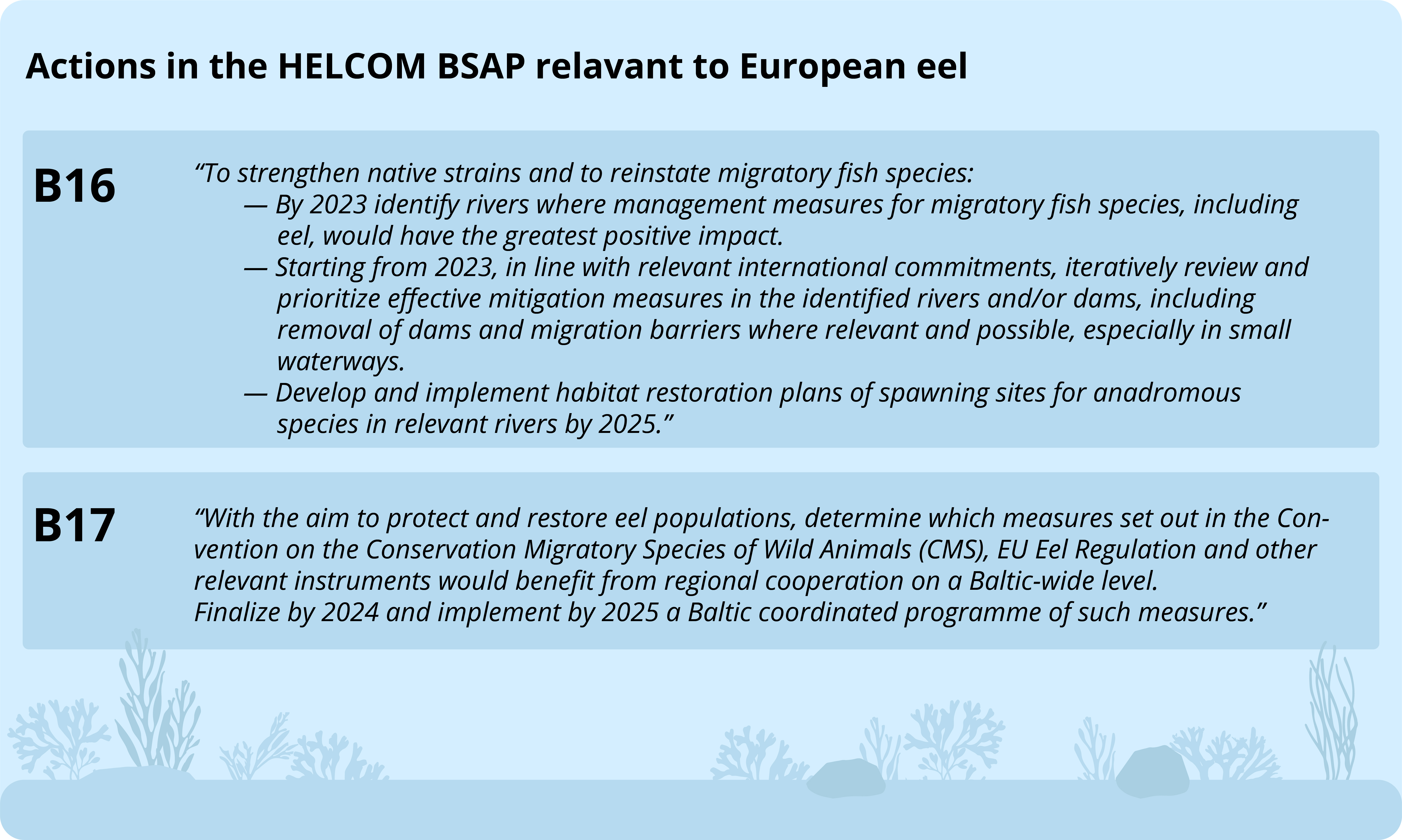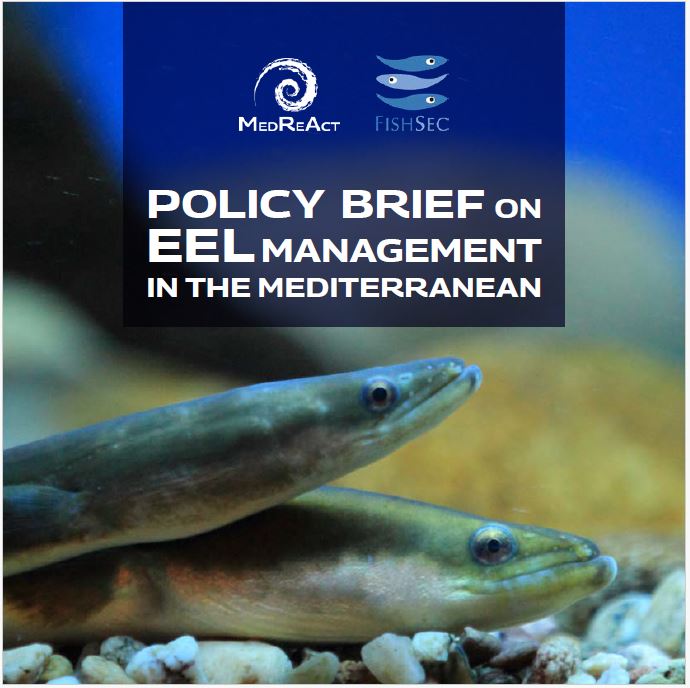Regional Management
Despite the fact that European eel consists of one single, widespread population there are several reasons to manage its recovery on a regional basis:
- It is believed that the eel larvae use two migration routes to European coastlines; one main route to the south with glass eels arriving along the southern coast of the United Kingdom and in the Bay of Biscay, as well as dispersing south to the Mediterranean and North African coast and north through the English Channel; and to a lesser extent north of Ireland and Scotland into Skagerrak and from there into the Baltic Sea or up along the Swedish west coast to the Norwegian coast.
- The decline in the population was first noted in the Baltic region around 1940, but was soon followed by other regions. The sex ratio in an area can be used as an indication of stock decline, as it is density dependent in eels. In crowded areas, more eels develop into males, which are smaller and mature earlier. The Baltic region has almost exclusively female eels.
The Baltic Region
The decline in European eel was first noted in the Baltic region. A paper by the Swedish fisheries scientist Gunnar Svärdson published in 1976 provides a detailed description, not only of the decline but also the development of the fishery, theories about migration routes and the potential effects of changes in temperatures and wind patterns in the North Sea. He describes an incredibly effective dispersal in the Baltic region, with eels found in 73 % of lakes in southern and central Sweden, as well as most of the lower lakes in the Gulf of Bothnia.
Today, a large part of the eel stock in the Baltic region is likely to consist of relocated eels, mainly from English rivers (until Brexit put a stop to that trade) and French waters. This is not a new practice, however. There are records from the 18th century, of trapping young eels at natural barriers, such as waterfalls, and releasing them elsewhere. A baseline for where and how many naturally dispersed eels there could be in the region is therefore full of uncertainties. What we do know is that natural recruitment in the North Sea region, which includes the Baltic, was estimated to be very low, only 0.6 % of the average in the 1960–1979 reference period.
European eel is therefore also listed as Critically Endangered by the Helsinki Commission (HELCOM) for the protection of the marine environment of the Baltic Sea area, as well as on many of the national Red Lists in the region. HELCOM’s latest Baltic Sea Action Plan (BSAP, 2021) contains several sections relevant to eel, as well as Actions with specific targets for European eel (Actions B16 and B17).

European eel is also frequently discussed in BALTFISH, both in the High-level group and with stakeholders at the BALTFISH Forum. The Baltic Sea Fisheries Forum (BALTFISH) was initially a flagship project under the EU Strategy for the Baltic Sea Region (EUSBSR), but became a permanent regional fisheries forum under the CFP in 2013, with an aim to strengthen and improve the Members States coordination and cooperation in fisheries management in the Baltic Sea. One of the key stakeholders is the Baltic Sea Advisory Council (BSAC), and European eel is among the topics that BSAC covers.
In 2018, European eel was added to the EU Specific Control and Inspection Programme (SCIP) managed by the European Fisheries Control Agency (EFCA), and has been included in the Joint Deployment Plan for the Baltic Sea.
OSPAR
OSPAR – HELCOMs sister convention for the North Sea – also sets targets for European eel and reports on its status. OSPARs most recent Status Assessment for European eel can be found here.
The Mediterranean and the GFCM
The General Fisheries Commission for the Mediterranean (GFCM) is a regional fisheries management organisation established in 1949 and is focused on ensuring conservation and sustainable use of living marine resources in the Mediterranean and the Black Sea. In 2018, the GFCM adopted a Recommendation for a multiannual management plan for European eel in the Mediterranean Sea (GFCM/42/2018/1), including a range of transitional management measures.
Following the Recommendation, the GFCM continued the discussions in the GFCM Working Group on the management of European eel (WGMEASURES–EEL), as well as at the Scientific Advisory Committee (SAC). The GFCM also implemented an eel research programme in the Mediterranean starting in 2020. In 2023, a permanent GFCM Expert Group on European eel in the Mediterranean (EGEMed) was created.
Since the 2018 GFCM Recommendation, States are required to submit data on eel fishing activities each year. The results of the most recent reporting show a likely decline in catches, number of fishers and fishing days between 2021-2022 overall, but an increase in the number of fishing vessels in Spain and France (EGEMed, 2023). However, the lack of consistent and continuous reporting of data on, for example, eel catches and fishing effort is a major obstacle to improved transparency and accountability in the management of the European eel across the Mediterranean region, and even in the EU.
Following the advice of the GFCM Scientific Advisory Committee in 2022 (SAC, 2022), the GFCM amended the Recommendation GFCM/42/2018/1 and established a total ban on recreational fisheries and extended the previous three-month closures to six months, to be implemented either as six consecutive months or separated into two periods of three months each. It also agreed to evaluate the possibility to implement additional measures directed to glass eel protection.
It is unlikely that these additional measures will be enough to secure eel recovery, as neither agreement is fully aligned with the scientific advice from ICES and the GFCM SAC advice (SAC, 2022). This autumn provides another opportunity to amend the current Recommendations, before deciding on a long-term management plan for European eel in the Mediterranean region in November 2024.

European eel is also listed under Annex III of the Barcelona Convention for the Protection of Marine Environment and the Coastal Region of the Mediterranean.
Our Policy Brief on eel management in the Mediterranean (English).
Our Policy Brief on eel management in the Mediterranean (French).
Last updated: May 2, 2024